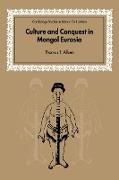Read more
Informationen zum Autor Thomas T. Allsen is Professor in the Department of History, The College of New Jersey, Ewing. His publications include Commodity and Exchange in the Mongol Empire: A Cultural History of Islamic Textiles (1997). Klappentext In the thirteenth century! the Mongols created a vast transcontinental empire that functioned as a cultural 'clearing house' for the Old World. Under Mongol auspices various commodities! ideologies and technologies were disseminated across Eurasia. The focus of this path-breaking study is the extensive exchanges between Iran and China. The Mongol rulers of these two ancient civilizations 'shared' the cultural resources of their realms with one another. The result was a lively traffic in specialist personnel and scholarly literature between East and West. These exchanges ranged from cartography to printing! from agriculture to astronomy. The book concludes by asking why the Mongols made such heavy use of sedentary scholars and specialists in the elaboration of their court culture and why they initiated so many exchanges across Eurasia. This is a work of great erudition which crosses new scholarly boundaries in its analysis of communication and culture in the Mongol empire. Zusammenfassung Thomas Allsen's latest book breaks new scholarly boundaries in its exploration of cultural and scientific exchanges across Mongol Eurasia. Contrary to popular belief! Mongol rulers were intensely interested in the culture of their sedentary subjects and! under their auspices! commodities! ideologies and technologies were disseminated from East to West. Inhaltsverzeichnis Part I. Background: 1. Introduction; 2. Before the Mongols; Part II. Political-Economic Relations: 3. Formation of the Il-qans, 1251-65; 4. Grand Qans and Il-qans, 1265-95; 5. Continuity and change under Ghazan, 1295-1304; 6. Sultans and Grand Qans, 1304-35; 7. Economic ties; 8. Overview of the relationship; Part III. Intermediaries: 9. Marco Polo and Po-lo; 10. Qubilai and Bolad Aqa; 11. Rashid al-Din and Pulad chinksank; Part IV. Cultural Exchange: 12. Historiography; 13. Geography and cartography; 14. Agriculture; 15. Cuisine; 16. Medicine; 17. Astronomy; 18. Printing; Part V. Analysis and Conclusions: 19. Models and methods; 20. Agency; 21. Filtering; 22. Summation....

